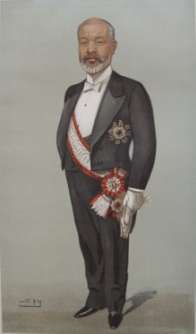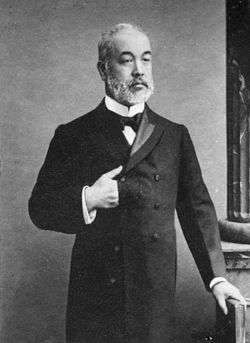Hayashi Tadasu
| Hayashi Tadasu | |
|---|---|
|
Count Hayashi Tadasu c. 1902 | |
| Born |
April 11, 1850 Sakura, Chiba, Japan |
| Died |
July 10, 1913 (aged 63) Hayama, Kanagawa, Japan |
| Nationality | Japanese |
| Occupation | Diplomat, Cabinet Minister |
Count Hayashi Tadasu, GCVO (林 董, April 11, 1850 – July 10, 1913[1]) was a career diplomat and cabinet minister in Meiji period Japan.
Early life
Hayashi was born in Sakura city, Shimōsa Province (present-day Chiba prefecture) .,[2] as the son of Satō Taizen, a physician practicing "Dutch medicine" for the Sakura Domain. He was adopted as a child by Hayashi Dokai, a physician in the service of the Tokugawa shogunate, from whom he received the family name "Hayashi", but he sometimes referred to himself as "Satō Tosaburō". He learned English at the Hepburn Academy in Yokohama (the forerunner of Meiji Gakuin University).
From 1866 to 1868, Hayashi studied in Great Britain at University College School and King's College London as one of fourteen young Japanese students (including Kikuchi Dairoku) sent by the Tokugawa government on the advice of the then British foreign minister Edward Stanley, 15th Earl of Derby.
Hayashi returned home in the midst of the Boshin War of the Meiji Restoration, and joined with Tokugawa loyalists led by Enomoto Takeaki, whom he accompanied to Hokkaidō with the remnants of the Tokugawa fleet. He was captured by Imperial forces after the final defeat of the Republic of Ezo at the Battle of Hakodate and imprisoned in Yokohama.
Released in 1871 by Kanagawa governor Mutsu Munemitsu, he was recruited to work for the Meiji government in 1871, and because of his language abilities and previous overseas experience was selected to accompany the Iwakura Mission to Europe and the United States in 1871–1873.[2]
Political career
On his return to Japan, Hayashi worked at the Ministry of Public Works, and later was appointed governor of Kagawa Prefecture, and then of Hyōgo Prefecture. In 1891, he was appointed Vice Minister for Foreign Affairs. He was elevated to the title of baron (danshaku) in the kazoku peerage in 1895.
Hayashi was appointed as resident minister to the court of Qing Dynasty China at the Japanese legation in Beijing, then resident minister to Russia in St Petersburg, and finally resident minister to Great Britain. While serving in London from 1900, he worked to successfully conclude the Anglo-Japanese Alliance and signed on behalf of the government of Japan on January 30, 1902.[2] He was elevated to the title of viscount (shishaku) in February 1902.
On December 2, 1905 Hayashi became the first Japanese ambassador to the Court of St James's, as diplomatic relations were upgraded between the Empire of Japan and the British Empire .[2] He was accompanied by his wife, Misao Gamo.[3] At that time Sir Claude MacDonald was Hayashi's opposite number in Tokyo.
On becoming Foreign Minister in the first Saionji cabinet in 1906, Hayashi concluded agreements with France (the Franco-Japanese Agreement of 1907) and Russia (the Russo-Japanese Agreement of 1907 and Russo-Japanese Agreement of 1910). He served as Minister of Communications in the second Saionji cabinet and as interim Foreign Minister (1911–12). He was elevated to the title of count (hakushaku) in 1907 .[2]
Hayashi died in 1913, and his grave is at Aoyama Cemetery in Tokyo.
Honors

From the Japanese Wikipedia
Titles
- Baron (31 October 1895)
- Viscount (27 February 1902)[4]
- Count (14 September 1907)
Decorations
- Grand Cordon of the Order of the Sacred Treasure (31 October 1895)
- Grand Cordon of the Order of the Rising Sun (27 December 1899)
- Grand Cordon of the Order of the Rising Sun with Paulownia Flowers (1 April 1906)
- Knight Grand Cross of the Royal Victorian Order (GCVO) (4 July 1905)[5]
Honorary degrees
- LL.D. (honorary) University of Cambridge - May 1902[6]
- D.C.L. (honorary) University of Oxford - June 1902[7]
Order of precedence
- Third rank (21 July 1901)
- Senior third rank (May 1910)
See also
- Japan–United Kingdom relations
- Henry Petty-Fitzmaurice, 5th Marquess of Lansdowne – who signed the Anglo-Japanese alliance of January 30, 1902 for Britain when Hayashi signed for Japan
- Japanese students in the United Kingdom
- Kikuchi Dairoku
- Imperial Rescript on Education
References
- The Secret Memoirs of Count Hayashi Tadasu, edited by A.M. Pooley, 1915, reprinted 2002 ISBN 1-4039-0334-4
- Kowner, Rotem (2006). Historical Dictionary of the Russo-Japanese War. ISBN 0-8108-4927-5: The Scarecrow Press.
External links
| Wikimedia Commons has media related to Tadasu Hayashi. |
| Wikisource has the text of a 1920 Encyclopedia Americana article about Hayashi Tadasu. |
- Portrait of Hayashi Tadasu on the website of the National Diet Library, Tokyo
-
 "Hayashi, Tadasu". Encyclopædia Britannica (11th ed.). 1911.
"Hayashi, Tadasu". Encyclopædia Britannica (11th ed.). 1911.
Notes
- ↑ Who's Who 1914, p. xxii
- 1 2 3 4 5 Kowner, Historical Dictionary of the Russo-Japanese War, p. 144.
- ↑ "Sitter: Viscountess Hayashi, later Countess Hayashi, née Misao Gamo (1858–1942)". Lafayette Negative Archive.
- ↑ "Latest intelligence – Japan". The Times (36704). London. 1 March 1902. p. 7.
- ↑ London Gazette, 4 July 1905
- ↑ "University intelligence". The Times (36779). London. 28 May 1902. p. 12.
- ↑ "University intelligence". The Times (36788). London. 7 June 1902. p. 9.
| Political offices | ||
|---|---|---|
| Preceded by Saionji Kinmochi |
Minister for Foreign Affairs 1906–1908 |
Succeeded by Terauchi Masatake |
| Preceded by Gotō Shinpei |
Minister of Communications Aug 1911 – Dec 1912 |
Succeeded by Gotō Shinpei |
